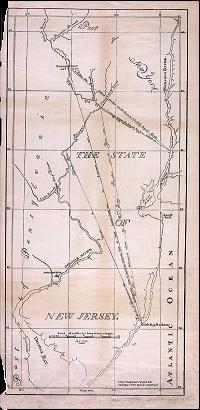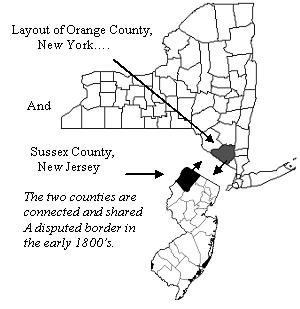| Research and Speculation about James EVERINGHAM U.E.L. (b.1755-1760 NJ)
James EVERINGAME (b.1757 PA)
are they the same person?...
Research and Speculation from:
Kathleen Everingham
with some input from:
Kevin Everingham, 2010 |
Name Pronunciations:
James Everingham U.E.L. was listed as "James Everingem" in Revolutionary War records. (example)
is it possible that he pronounced it Ev-rin-Gam with an emphasis on the "g"? English pronunciation could easily have sounded like; "Ev-rin-gum".
Listen to how this similar name is pronounced - (Sheringham)
James Everingame who married Ann Quick is listed in Quick family records with a last name of "Everingame" - a name that doesn't appear anywhere else, did that name ever exist, or was this just the way the Quick family or this James pronounced his name? (Eve-rin-gam)?
We do know that there is a last name of "Everingam" in the U.S. but we also know that it is an offshoot of the Everingham family and if you trace that family back far enough, their name was Everingham long after James (b.1730) lived. Bottom line... it is highly probable that James Everingame who married Ann Quick in 1754 was an "Everingham" and further circumstantial information shows a "possibility" that their son James (b.1757) could be James who married Chloe Dell in NJ, 1780....
(Kathleen Everingham, August, 2010) You "Kevin" pose 2 theories about WHO IS JAMES?
Theory #1 gives James birthplace as Upper Smithfield, Bucks Co., Pennsylvania.
Theory #2 gives James birth date as between 1755 and 1760, in Trenton, Mercer Co., New Jersey.
What is MINISINK?
Bucks Co,PA and Mercer Co, NJ both fall into the old Minisink area. Because of the way Minisink became divided among three different states, it's reasonable that James birth records (if any exist) got recorded and stored in two states, New Jersey and Pennsylvania. Location-names may have changed between the year he was born and the year he enlisted with the Jersey Volunteers, but I have yet to find evidence of this.
The term Minisink referred to a vast territory along the Delaware valley in the tri-state region of NY/NJ/PA. However, Only two areas were settled before 1700, Peenpack and Machackemeck.
(Source for the above) other records: MINISINK VALLEY REFORMED DUTCH CHURCH RECORDS for Shapanack scroll down the pg to #XIX | HISTORY OF MINISINK | UPPER SMITHFIELD, BUCKS CO., PA Chapt. 37, page 581.
 During early years of settlement Minisink country covered what is now a tri-state area. Minisink was later divided up and sections of it assigned respectively to NY, NJ, and PA. Draw a circle on the map over the area where New Jersey, New York, and Pennsylvania touch, and that circle is what was long ago, Minisink territory. Thus, "Upper Smithfield, Bucks Co.,PA" where James Jr. was reportedly born, was in Minisink where his parents married circa 1754, and also the same place where his mother was born. Her birth location of "Shippenknok," a Minisink community. And her birthplace of Machackemek, was one of the first settlements.
During early years of settlement Minisink country covered what is now a tri-state area. Minisink was later divided up and sections of it assigned respectively to NY, NJ, and PA. Draw a circle on the map over the area where New Jersey, New York, and Pennsylvania touch, and that circle is what was long ago, Minisink territory. Thus, "Upper Smithfield, Bucks Co.,PA" where James Jr. was reportedly born, was in Minisink where his parents married circa 1754, and also the same place where his mother was born. Her birth location of "Shippenknok," a Minisink community. And her birthplace of Machackemek, was one of the first settlements.
This map (shown right) shows a colonial shift of boundary between NJ and NY is shown here, click on the map to see more detail. Shapanack, Machackemek
Machackemek referenced in "Early Dutch Explorations into the Minisink Region" author: Mead Stapler
"On July 10, 1719, John Reading, Jr. a West Jersey Commissioner participating in a survey of the controversial New York/New Jersey boundary, describes in his journal meeting with the Canomakers and their unique craft at Cushatunk, now Damascus, Pennsylvania (Reading 1719:104). Their village is just across the Delaware River from Station Point, the northwestern point of the Royal Charter for New Jersey at 4140' north latitude that this survey party was sent to establish. John Reading is intrigued by the unusual boat of these Indians and spends the good part of a day watching them build their distinctive bark canoes. Most other Indians of the region laboriously hollowed out tree trunks to create their vessels. A day or two later several of the other New Jersey surveyors hired these same people to transport themselves and their equipment back down the Delaware in these canoes to Mahackamack, now Port Jervis, New York."
 (Kevin) - Because of my research on a related family from Orange County, NY and Sussex County, NJ, I am aware that a boundary dispute existed between New York and New Jersey. Due to many boundary disputes between New York and New Jersey, much of the records of small towns of this area do not exist until the 19th century. The Cheesecocks Patent was a surveyed tract of land which covers the modern towns of Monroe & Tuxedo New York. This tract was purchased from the Indians March 20th, 1707. The original Cheesecocks survey laid out allotments four and a quarter miles beyond the county line which caused the disputes between New York, New Jersey and even Pennsylvania. The combined area of disputed land (as Kathleen says) is known as the Minisink, an area of farming and mining communities.
(Kevin) - Because of my research on a related family from Orange County, NY and Sussex County, NJ, I am aware that a boundary dispute existed between New York and New Jersey. Due to many boundary disputes between New York and New Jersey, much of the records of small towns of this area do not exist until the 19th century. The Cheesecocks Patent was a surveyed tract of land which covers the modern towns of Monroe & Tuxedo New York. This tract was purchased from the Indians March 20th, 1707. The original Cheesecocks survey laid out allotments four and a quarter miles beyond the county line which caused the disputes between New York, New Jersey and even Pennsylvania. The combined area of disputed land (as Kathleen says) is known as the Minisink, an area of farming and mining communities.
"The region was a valley near the Delaware River, first settled by the Dutch (Hollanders) around 1610; Holland ceded the territory to England in 1664. During English Colonial ownership New Jersey was partitioned into East Jersey and West Jersey; the region's official state boundaries weren't firmly established until around 1830. At the time of The Revolutionary War the valley was the frontier settlement of Orange County and part of Ulster which was continually, from the spring of 1777 to the end of the war, harassed by Tories and Indians."
Battle of Minisink
"On the night of July 19, 1779, Joseph Brandt, Mohawk Chief and British Army Colonel, at the head of sixty Indians and twenty-seven Tories disguised as savages, stole upon the little town of Minisink, Orange County, NY, which was wholly unprotected, and, before the people were aroused from their slumbers, set on fire several houses. Several of the inhabitants were killed, and some were made prisoner." Sources: (source1 | source2)
James Everingham Jr. would have been about 22 years old when this massacre occurred that triggered the Battle of Minisink.
If James Everingham had been living there at the time, it seems possible that his name may appear somewhere as a survivor, or a victim, if any records of that event & area remain. It's also extremely doubtful that if he was a survivor of it, that he would have served on the Tory side as James Everingham U.E.L. did. Minisink supported the Revolution. He could have left to join the Continental Troops at age 20; on the other hand, if he had Loyalist sentiments, had moved or had Loyalist friends,.. he may have left and joined the Tories?
|